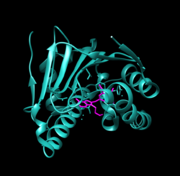Sandbox chaperones
From Proteopedia
Contents |
Chaperones
This page is setup for Paige to build her senior project for OU CHEM 4923
|
Function
The primary function of Chaperones is protein folding. They are proteins that assist/chaperone other proteins as they fold or unfold and assemble or disassemble in order to prevent misfolding and unwanted protein aggregation.
Some chaperones function closely with ribosomes in order to help fold newly made proteins, sometimes co-translationally. However, most proteins will fold spontaneously without the help of a chaperone. Chaperones become necessary for most proteins only when the intracellular environment becomes too crowded, thus increasing the chances of protein aggregation unless aided by a chaperone. See also Chaperones.
Many chaperones are heat shock proteins (typically abbreviated as "Hsp" with the approximate molecular weight afterwards) that are expressed in response to high temperatures or other cellular stresses which impact protein folding. In these environments chaperones function to prevent or correct damage caused by misfolding and to prevent unwanted protein aggregation, which is more likely to happen when proteins are denatured by stress. Some heat shock protein chaperones are present at low to moderate levels in virtually all organisms at all times in order to help in essential protein maintenance. [1]
A special type of heat shock protein is Hsp90. Hsp90 is part of a chaperone complex with other general chaperones and functions to assist in the maturation of a select clientele of proteins. What exactly Hsp90 does to it's client proteins is the part of it's function that is still a mystery. Furthermore, a link between client proteins other than the fact that they all require Hsp90 to maintain active forms is of yet unknown.[2]
Structural highlights
Hsp90 secondary structure consists of nine alpha helices and eight anti-parallel beta sheets. Hsp90 is a cytoplasmic protein, which makes it necessary for it to be globular. This means it orients it's hydrophobic residues toward it's interior so as not to cause energetically unfavorable clashes with water in the cytoplasm.
Hsp90 consists of four structural domains and it's functional form is a homodimer. The binding sites holding the dimer together are in the C-terminal domain only in the open conformation, but the N-terminal domain comes into play in the closed conformation. Hsp90 has three functional domains: the ATP-binding domain, the client protein binding domain and the dimerizing domain. [3]
Energetics

The inactive form of Hsp90 is open, but binding of ATP causes the molecule to close into the active form. The N-terminal domain is the cite of the ATP binding pocket. Amino acids Leu34, Asn37, Asp79, Asn92, Lys98, Gly121, and Phe124 are in the N-terminal domain and are directly involved in ATP binding. Mg2+ is also present and involved in electrostatic bonding interactions with ATP. This results in a high-affinity ATP-binding site. Hsp90 binds ATP when in the open/inactive conformation and then cleaves the ATP into ADP to drive the conformational change into the closed/active form.[4]
The protein binding domain is in the C-terminus. Hydrophobic residues in the C-terminus are exposed while the dimer is in the open conformation, allowing unfolded and misfolded client proteins to bind. When the N-terminal domain hydrolyzes ATP and drives the confirmation change the C-terminal domain clamps down on the client protein.[5]
Disease
Because many client proteins of the chaperone protein Hsp90 are involved in cellular growth, inhibition of the ATPase activity of Hsp90 is a potential strategy for the treatment of cancers.
Geldanamycin is a natural product made by Streptomyces bacteria that blocks the binding of ATP to Hsp90. This freezes the large conformational change needed for function and causes complexes of Hsp90 and misfolded proteins to accumulate in the cytoplasm. These accumulated proteins are then targeted for degredation by the ubiquitin/proteosome system, which ultimately leads to cell death as a result of corrupted growth controlling signaling pathways. Unfortunately, geldanamycin is too toxic to normal body cells for use as an anticancer drug.[2]
However, less toxic compounds with the same mechanism have been developed. A ligand called PU3 is a purine based inhibitor that has been developed using human Hsp90 protein 1UYM for the potential purpose as an anticancer drug targeted at HSP90 proteins. PU3 tightly binds the ATP binding site of 1UYM and causes downregulation on it's client proteins. This results in misfolded proteins accumulating in the cell and eventual cell death. [6]
It is important to note that although Hsp90 is essential in normal cells to aid in general protein maintenance, cancer cells rely more heavily on Hsp90 and therefore respond more strongly to downregulation. Therefore Hsp90 inhibitors are more detrimental to cancer cells than normal cells.[2]
References
- ↑ Ellis, R.J. and van der Vies, S.M. (1991). "Molecular chaperones". Annual Review of Biochemistry 60: 321–47
- ↑ 2.0 2.1 2.2 2.3 Goodsell, David. (2008). "Molecule of the Month: Hsp90." Education Portal of Protein Data Bank. doi: 10.2210/rcsb_pdb/mom_2008_12
- ↑ Prodromou C, Pearl LH (October 2003). "Structure and functional relationships of Hsp90". Curr Cancer Drug Targets 3 (5): 301–23. doi:10.2174/1568009033481877. PMID 14529383.
- ↑ Prodromou C, Roe SM, O'Brien R, Ladbury JE, Piper PW, Pearl LH (July 1997). "Identification and structural characterization of the ATP/ADP-binding site in the Hsp90 molecular chaperone". Cell 90 (1): 65–75. doi:10.1016/S0092-8674(00)80314-1. PMID 9230303.
- ↑ Grenert JP, Sullivan WP, Fadden P, Haystead TA, Clark J, Mimnaugh E, Krutzsch H, Ochel HJ, Schulte TW, Sausville E, Neckers LM, Toft DO (September 1997). "The amino-terminal domain of heat shock protein 90 (hsp90) that binds geldanamycin is an ATP/ADP switch domain that regulates hsp90 conformation". J. Biol. Chem. 272 (38): 23843–50. doi:10.1074/jbc.272.38.23843. PMID 9295332.
- ↑ Wright L, Barril X, Dymock B, Sheridan L, Surgenor A, Beswick M, Drysdale M, Collier A, Massey A, Davies N, Fink A, Fromont C, Aherne W, Boxall K, Sharp S, Workman P, Hubbard RE. Structure-activity relationships in purine-based inhibitor binding to HSP90 isoforms. Chem Biol. 2004 Jun;11(6):775-85. PMID:15217611 doi:http://dx.doi.org/10.1016/j.chembiol.2004.03.033

